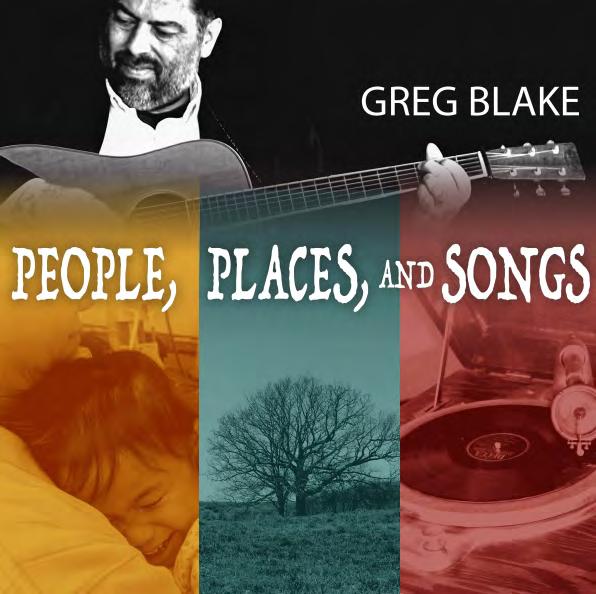





































The Bluegrass Standard is a life-long dream of Keith Barnacastle, who grew up in Meridian, Mississippi. For three years, Keith brought the Suits, Boots and Bluegrass Festival to Meridian. Now, with the Bluegrass Standard, Keith’s enthusiasm for the music, and his vision of its future, reaches a nationwide audience every month! Keith@TheBluegrassStandard.com


Richelle Putnam is a Mississippi Arts Commission (MAC) Teaching Artist/Roster Artist (Literary), a Mississippi Humanities Speaker, and a 2014 MAC Literary Arts Fellowship recipient. Her non-fiction books include Lauderdale County, Mississippi; a Brief History, Legendary Locals of Meridian, Mississippi and Mississippi and the Great Depression. Richelle@TheBluegrassStandard.com
Speer • Creative Director
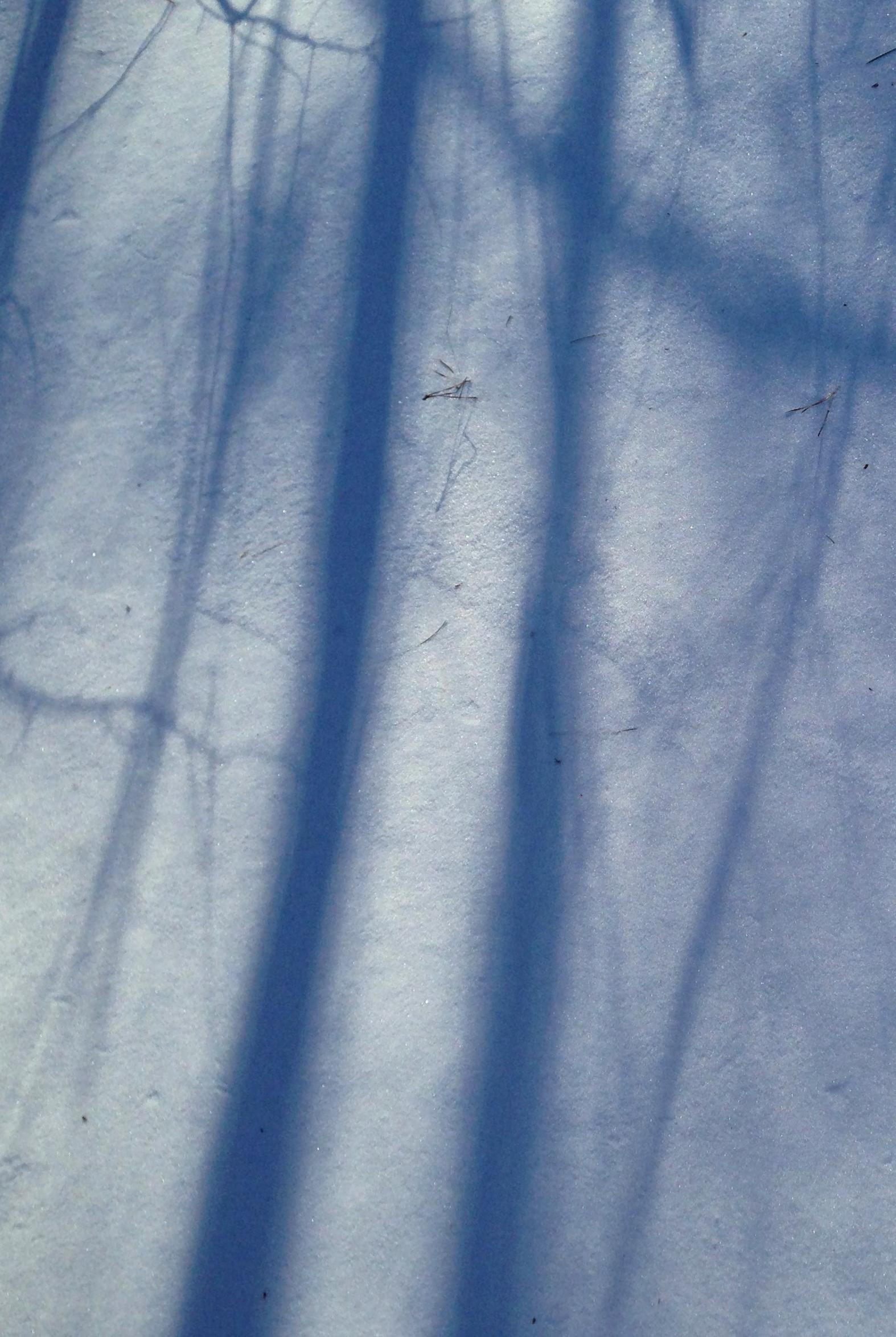
Rebekah Speer has nearly twenty years in the music industry in Nashville, TN. She creates a unique “look” for every issue of The Bluegrass Standard, and enjoys learning about each artist. In addition to her creative work with The Bluegrass Standard, Rebekah also provides graphic design and technical support to a variety of clients.
Susan traveled with a mixed ensemble at Trevecca Nazarene college as PR for the college. From there she moved on to working at Sony Music Nashville for 17 years in several compacities then transitioning on to the Nashville Songwritrers Association International (NSAI) where she was Sponsorship Director. The next step of her musical journey was to open her own business where she secured sponsorships for various events or companies in which the IBMA /World of Bluegrass was one of her clients.


Shelby Campbell is a writer and designer whose heart beats for creativity. A native of rural Livingston, AL, she found her passion in journalism and design at The University of West Alabama, where she received a Bachelor’s degree in Integrated Marketing Communications. Shelby also has her own photography business.


Susan Marquez is a freelance writer based in Madison, Mississippi and a Mississippi Arts Commission Roster Artist. After a 20+ year career in advertising and marketing, she began a professional writing career in 2001. Since that time she has written over 2000 articles which have been published in magazines, newspapers, business journals, trade publications.

Kara Martinez Bachman is an author, editor and journalist. Her music and culture reporting has appeared in dozens of publications and she’s interviewed many performers over the years, from local musicians to well-known celebrities. She’s a native of New Orleans and lives just outside the city with her husband, two kids, and two silly mutts.
Candace Nelson is a marketing professional living in Charleston, West Virginia. She is the author of the book “The West Virginia Pepperoni Roll.” In her free time, Nelson travels and blogs about Appalachian food culture at CandaceLately.com. Find her on Twitter at @Candace07 or email CandaceRNelson@gmail.com.

From a very early age, Amelia Brown loved the experience of playing bluegrass music. At six years old, she picked up her first stringed instrument—the guitar. Today at age 14, she plays guitar, piano, dobro, and bass fiddle.

According to Brown, her journey with music didn’t start with the guitar, though. At only four years old, she clogged in competitions with her sister Reagan and started piano lessons, picking up the guitar soon after.
“My sister and I started clogging together and going to bluegrass competitions to compete,” Brown said. “That’s how my sister talked me into learning to play the guitar, by being at these competitions for clogging. Once I learned to play, we were able to compete for music also.”
By 2020, Brown was trying her hand at learning the dobro, and later that year, she learned to play the bass fiddle for her band.
“I love to play anything with strings,” Brown said. “I was really drawn to bluegrass music because it sounds so authentic.”
Brown’s connection with the music she plays is something that she associates with her relationship with her grandfather, who loved to play old country music and bluegrass musicians like Dailey & Vincent.
“My granddad would take me and my sister places to see bluegrass music, and I feel like I have a deeper connection with bluegrass music because of my granddad. I feel more in tune with my music and feel really connected,” Brown said.
However, Brown’s grandfather wasn’t the only bluegrass influence in her career as a young musician. A significant influence on her as a young artist has been Springfield Guitar Company, where she has been taking guitar lessons since the second grade. Brown has been taking lessons there several days a week alongside her sister Cara Brown, Frannie Bryson, and Gary Adams.
Springfield Guitar Company began hosting old-time music jam sessions each Monday night in 2020, and it was at these sessions Brown and her sister met the artists that would become their first bandmates.
Today, Brown is a member of three different bluegrass bands: the TriState Ramblers, made up of three sets of siblings from Kentucky, Alabama, and Tennessee; a duo with her sister aptly named She’s My Sister, and Can’t Drive Yet, a group of young musicians all 14 years old and under.
As a part of her bands, Brown has performed at countless bluegrass festivals, churches, schools, and events over the last few years, and placed in competitions for her bluegrass bands and guitar, dobro, square dance, and clogging.
“Performing with my sister in our duo makes things fun and gives us new experiences. It has taught me to learn to do things differently and how to speak onstage. My sister doesn’t like to speak onstage, so it’s given me a new perspective,” Brown said.
Brown has been on WoodSong Old Time Radio twice—once as the WoodSong kid and once with
her sister for the pilot of WoodSongsKids. This year, Brown started stacking up accomplishments in music and received the Houston Caldwell scholarship to attend Rob Ickes’ Reso-Summit in November 2022.
“While I was at the Reso-Summit, I got the opportunity to meet a lot of new dobro players who piqued my interest in many areas. I also got to see and learn from many musicians who have influenced me, like Rob Ickes and Jerry Douglas. This event made me look at things differently and taught me not to always look at just the basic melody in my music,” Brown said.
The Tennessee Arts Commission Folk Life Program awarded Brown one of twelve 2022-23 grants for a mentorship with Tim Graves for Graves-Style dobro playing.
“This opportunity is absolutely extraordinary!” Brown said. “Tim Graves is Josh Graves’ nephew, and he has become such a hero to me in my music. Every Tuesday beginning in December, he will teach us Josh Graves’ style of playing dobro. Once the program is over, I also get to perform onstage with him and his band.”
Among her musical influences, Brown says some favorites are Trey Hensley and Jamie Dailey of Dailey & Vincent on guitar, Tim Graves, Rob Ickes, Josh Graves on dobro, and Mike Bub on bass.
“The Osbourne Brothers have also had a big influence on how I sing my music and perceive the music I am playing,” Brown said.
When asked about a potential music career, Brown said she would love the opportunity to record her original music one day, but she isn’t ready for that quite yet.
“Recording music is definitely something that has interested me, but doing so would disqualify me from some of the music competitions I enter with my bands. So for now, I am going to keep competing with my bands, but that is a possibility for later on,” Brown said.
Her love of bluegrass, engrained in her from a young age, led her to the bluegrass community. Brown and her sister joined Tomorrow’s Bluegrass Stars, whose mission is to preserve bluegrass music one youngster at a time through encouragement and music promotion.
“The TBS leaders have been so nice and encouraging, reminding us always to try,” Brown said. “They’ve really been so kind, generous, and patient in their time with us.”
Today, Brown hopes to see her bands prosper and bless people with their music. She would love to major in bluegrass music when she gets to college to help her in her goal of playing dobro like her heroes.

“I’ve learned not to try to be like everyone else, to find my style and have fun with it. You have to take things from people here and there that you admire and create your own sound,” Brown said. “Bluegrass music gives me a different view of the world. It makes people see things in a different way, and I would love to eventually be as influential on dobro as some of my musical heroes.”


Cristina Vane plays clawhammer banjo, but she has as much old time in her as she has pluggedin rockstar. She’ll jam like Slash from Guns N’ Roses, and she’ll study the country vibe of Jerry Reed. She’ll lay into some Delta blues that sound like Blind Willie Johnson. She’ll play slide on a resonator or craft something that seems like a mix of all things.
time in England; schooled herself in New Jersey, and grew as a performer while busking on Venice Beach.
While living there in L.A., Vane – whose roots were in rock and even punk – became fascinated with –and began to delve deeply into – blues, bluegrass, and
how floating cross-culture is a motif that might make her music more expansive. “It puts me in the role of a sort of cultural observer. I spent a lot of time watching…when I’m out touring, it’s a lot of observing. This country is so big, and that’s cool to me.”
It’s not odd, she seems to think. She’s just doing what interests her, without regard for shaping an image. It’s just all her, exploring what tickles her fancy. It’s all about being her authentic self, always.
“I feel as though my authentic self is… multidimensional,” Vane said. “And it follows that my music is multidimensional.”
It’s no surprise that her music reflects a variety of experiences and interests. A life of living everywhere— and nowhere—informed her paradigm. Today she calls Nashville home, but Vane was born in Italy; lived as a child in Paris; spent some
Americana forms, styles, and instruments.
“I got a job at a guitar shop and got my first cheap resonator,” Vane recalled. She soon found a guitar mentor, then began going to open mics and busking on the boardwalk in Venice.

“Then I went on a six-month tour,” she said. “I did ten shows a month or so, living out of my car and tent.”
According to Vane, these itinerant meanderings are part and parcel of who she is and has always been and seem at the core of that authentic self she seeks to share with listeners.
“It’s been a constant sense of not really being from anywhere,” she said, relaying
Sometimes, Vane will have people ask about the fact that she’s a woman playing the blues, and this rubs her the wrong way. Why can’t a woman play the blues? Why even ask that question?
“I fundamentally believe that women are treated differently,” she said. Vane saw this even as a youngster.
“All the people I saw living the rock star dream were men,” she said. “Women aren’t even involved [in rock] unless they’re groupies.”
Vane recalls that she always wanted to live a life similar to Slash from Guns N’ Roses. For women musicians, there were few female role models to relate to. There were few examples to emulate.
“Who’s my Slash?” Vane asked rhetorically.
Over time she has updated her goals, and the result is a
well-rounded constellation of influences and interests.
“I love rock music,” she said, “but I also play soft banjo. I play clawhammer banjo, so part of my set is old-time music.”


Vane has released two albums, the most recent being the May release of Make Myself Me Again. Vane said it has done well—people like what she’s putting out there.
“It’s been really good,” she said. “I’m pretty small fry, so I get excited when it’s played on the radio. People seem to like it.”
As for the future, Vane said she’ll probably take a little break from heavy touring in the near future and will “hunker down for the winter” and work on her next record.
She gives no specific timeframe for when that’s projected to drop but assures it probably won’t be until sometime in 2024. She’s recorded two records in two years, and there’s no rush on the third.
“I’m really grateful,” Vane said. “I’m grateful that now that I’m trying to make a living doing this, there are people whose support helps keep the dream alive.”



A certain kind of person makes a lasting impact on the world they leave behind, but often, the impact is not apparent to the person. Gaelynn Lea, a musician, public speaker, and disability rights activist, is undoubtedly that certain kind of person. At only 38 years old, she has influenced others so profoundly that people will talk about her work for years.
Lea was born with Osteogenesis Imperfecta or Brittle Bones Disease, but she hasn’t let that stop her from pursuing her dreams. She was rooted in the thriving music scene of her hometown of Duluth, Minnesota, from the first moment she heard an orchestra play at her elementary school.
Immediately inspired to pick up a stringed instrument, Lea began playing the violin at ten years old due to an orchestra teacher willing to take a chance and help her adopt a method of playing the violin that fit Lea’s abilities.
“I also grew up around music,” said Lea. “My mom was choir director at my church, and my family owned a dinner theater. Duluth is a very musical town. It’s a beautiful port town near Lake Superior with natural beauty and a musical community that really shapes artists.”
Lea found her sound in college, being drawn to Celtic music through extracurricular groups and jam sessions, and eventually found her way to playing violin in folk groups and writing her music. She has become known for her haunting original songs and approach to traditional fiddle music.
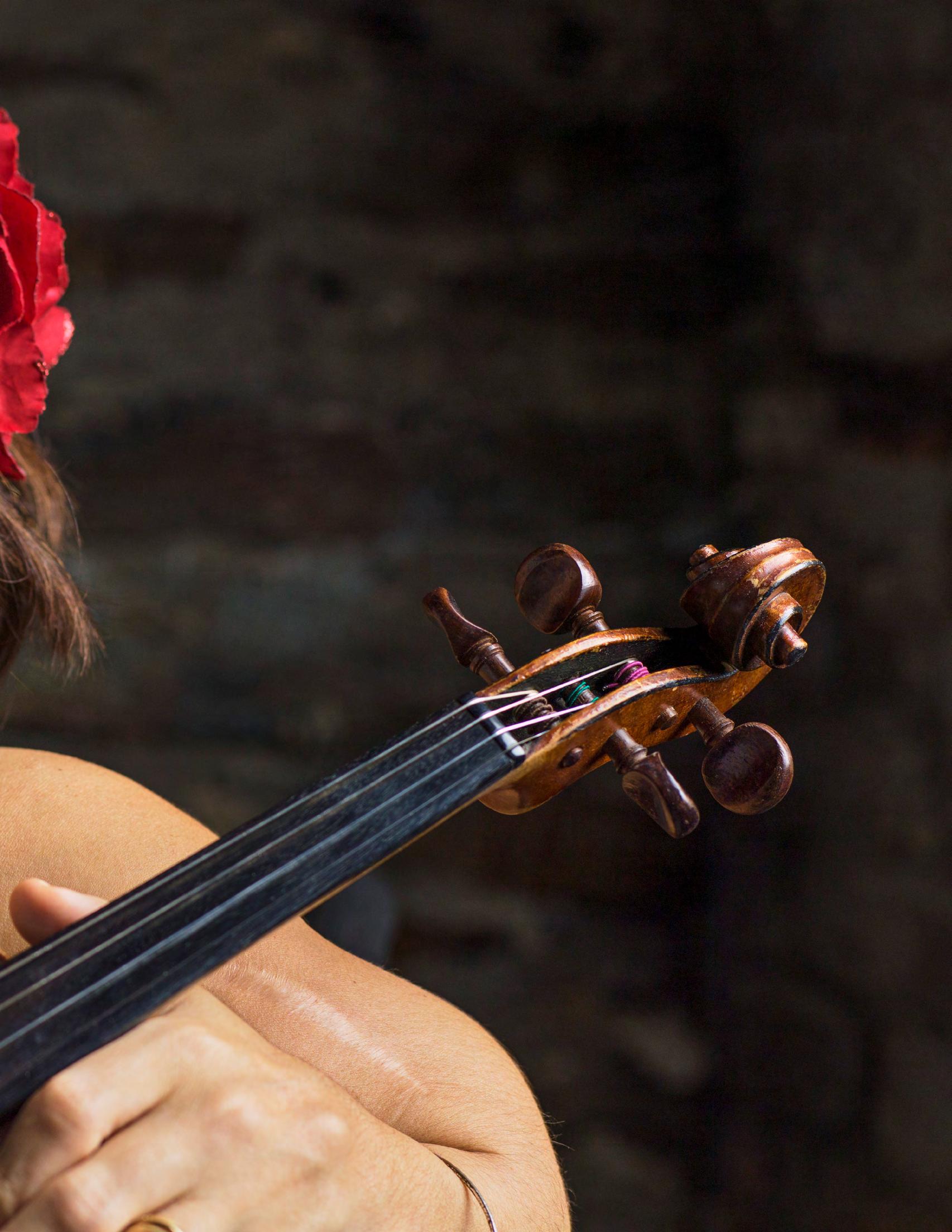
Combining this with her incorporation of live looping and sonic exploration has made her an artist like none other—creating a place for herself in the music industry all her own, opening up for artists like Wilco, LOW, The Decemberists, and Pigface.
“I like having the combination of both traditional and unique, modern music. My original music is more experimental and spooky,” Lea said. “With the looping peddle, fiddle tunes have a lot of repetitive chord structures. It’s exciting for me to create new and innovative ways to perform music that has been around for hundreds of years. I love bringing those tunes to a modern audience.”
In 2016, Lea won National Public Radio’s Tiny Desk Contest, introducing her to a continuously broad audience of fans, touring, and a community she didn’t know she was missing. It also opened up other opportunities, including Lea’s most recent accomplishment—composing the music for Macbeth on Broadway. This iconic Shakespeare play, starring Daniel Craig and Ruth Negga and directed by Sam Gold, was nominated for three Tony Awards, including Best Sound Design.
“Growing up, musical theater was in our DNA,” Lea said. “So, getting to do the music for Macbeth on Broadway last year and really getting back into theater made it such a full circle moment for me.”
Lea is known for so much more than her music, however. She also uses her platform to advocate for people and artists with disabilities. She has become a sought-after public speaker on disability rights, accessibility in the arts, finding inner freedom, and the power of music.
Lea regularly speaks at universities, conferences, and music festivals and has multiple widely-viewed TEDx Talks. She shared her experiences on PBS NewsHour, On Being with Krista Tippett, The Moth Radio Hour, NowThis, The Science of Happiness Podcast, and Reese Witherspoon’s Hello Sunshine My Best Break-Up Podcast, all while touring the world with her music.
“In the beginning, I started speaking because I had a terrible phone call with a case worker about healthcare after I got married.” Then, Lea talked with a social worker friend and started having enlightening discussions about her experiences and doing general disability speaking.
“Winning Tiny Desk, it became clear that accessibility was not something that was talked about in the music industry. I shifted my speaking to being more music-focused and why it’s important to have visibility and diversity in the music industry,” Lea said. “Music is still my passion, but as long as speaking is something I can help move the conversation forward, I’ll keep doing that.”
Focusing on the universality of disability culture and the fact that 26 percent of Americans have some form of disability, Lea has made it her mission to break down the norms of our society, specifically in the music industry.
Part of this goal was becoming the Co-Founder of RAMPD, Recording Artists and Music Professionals with Disabilities. The mission of this fast-growing group led by people with disabilities is to amplify disability culture, promote inclusion, and advocate for accessibility in the music industry.
“My Co-Founder Lachi and I


officially launched RAMPD in January of 2022. Our main goals were to provide accessibility consulting and artist development to help artists with disabilities get more established. We wanted to become a source for groups and companies when they want to know how to become more diverse and inclusive,” Lea said.
In less than a year, RAMPD has already helped make the Grammy Awards accessible for the first time in history.
“The time is right. People understand diversity is important,” Lea said. “They’ve never thought of it. Folk Alliance has been very supportive as well. They created a whole summit topic on accessibility and invited us to be a part of it. For the first time, they had ASL and captioning. These changes need to happen.”
Working with the Recording Academy on consulting through RAMPD has led to additional opportunities for Lea. She is now a voting member of the Recording Academy, lending her unique perspective and creating awareness for artists with disabilities.

“I’d love to focus on committing to keeping RAMPD growing,” Lea said. “Seeing accessibility as a built-in part of the music industry is the goal.”
As if she wasn’t already busy enough, Lea is currently working on writing a memoir about her life in music and disability advocacy as well. She says that disabilities are a contribution to culture rather than something to overcome. As a person with disabilities, she connects to the world differently and sees through a different lens.
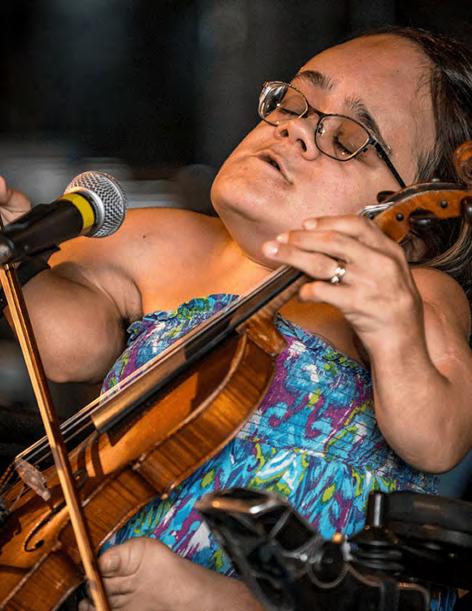
If Lea’s music and projects indicate in some way how she views the world, then her view must be extraordinary.
“It always feels like you are on a journey in music, but it’s exciting to present a more inclusive way for all,” Lea said. “To reimagine what the music industry could look like is exciting. We do things the way we’ve always done them, but it’s great to think outside the box.”
 Kara Martinez Bachman
Kara Martinez Bachman
Hillary Klug is well-rounded and multifaceted, like the most interesting of gems. Not only does she play fiddle, but she also sings while she does it…and dances! When she entertains her audiences, she hits them with all she’s got. It’s clear to see when a performer is “all-in,” and in the case of Klug, her talent trifecta brings a real sense of energy.
“It’s unique,” Klug agreed, “and so it has distinguished me from all my peers because it’s completely different and memorable.”
That said, Klug describes her talent with admirable humility and self-awareness.
“I’m actually not a very impressive fiddler or vocalist or dancer. I’m very mediocre,” she said, adding that many vocalists, fiddlers, and dancers are more skilled than her. She’s figured out how to do all three simultaneously, so she agreed that it makes her “stand out.”
“I’ve done so much fiddling and dancing at the same time that I’m a better fiddler when I dance, and I’m a better dancer when I fiddle,” she said. “I’ve put the fiddling and dancing together in such a way that the entertainment factor has attracted audiences outside of the bluegrass world. I’m very proud of that. I have people watching and listening who would otherwise never be exposed to this type of music.”

Klug described the interplay between music and dance.
“My dancing is more than just entertainment,” she said. “I’m making music with my feet. My dancing lays a good rhythmic foundation for my fiddle music.”
Klug is a two-time National Buck Dancing champion. This style is similar to clogging but is “a lot older and more traditional, and clogging has evolved from buck dancing much the same way bluegrass has evolved from old-time music.”
“Cloggers dance to the music, but the sounds from their feet don’t contribute to the music,” she explained, differentiating the two styles. “A buck dancer is a musician; their feet are their instrument. It’s a solo dance, and it’s always improvised. Buck dancing is not standardized or formalized like clogging. Each unique buck dancer has their unique style, as the dance is learned the traditional way, passed down from generation to generation.”
Klug has always loved Irish music and dance and includes it in her repertoire. “I started clogging when I was eight. I grew up listening to country music, mostly because I was a daddy’s girl, and that was his kind of music. I started playing fiddle at age 13,” she said. “I learned some Irish dancing with a local group in Bellbuckle around age 18, and later I took a trip to Ireland to learn Irish dancing from real
Irish dancers.”
Klug explained that there’s an Irish dance called “Sean Nos,” and it’s the Irish equivalent of buck dancing. She enjoys performing in both styles.
“Unlike the rigid River dancing with a stiff upper body, Sean Nos is relaxed with loose, dangling arms,” she explained. “Sean Nos is always improvised, and it’s all about making music with the feet.” She’s learned a few Sean Nos steps and incorporated them into a few videos and songs during her shows. “I’ve learned steps in both 2/4 and 6/8 time in order to dance to both reels and jigs.”
She learned more about Irish dancing directly from the source; she went to Ireland. “I had been dancing in my big clunky dance boots, and I didn’t realize I had been dancing on my heels with my buck dancing,” she said. “My footwear had dictated my dance style, with the heavy heels on my boots. When I tried learning Irish dance, I had a hard time at first with my big clunky dance boots. Did you know Irish dancers dance on their toes? I couldn’t do the Sean Nos dancing in my boots, so I changed into tap shoes to dance on my toes and execute the more delicate Sean Nos dance steps with precision.”
Unsurprisingly, she’s interested in Celtic and Appalachian music; there’s overlap.
“Many settlers in Appalachia were of Scotch-Irish heritage, and they brought their Celtic music with them to America,” Klug said. “Celtic music was one of many influences in bluegrass music as we know it today. There are many differences, including the fact that bluegrass repertoire doesn’t include any jigs. Also, bluegrass fiddle tunes emphasize the backbeat, whereas Irish fiddle tunes emphasize the downbeat. Bluegrass music has a lot of blues notes and rhythms that come from its African influences. There are no blues whatsoever in traditional Celtic music.”

Klug said she is drawn to old-time

fiddle music that is “related” to Celtic music and plays some Americanized versions of Celtic music tunes.
“For example, the tune ‘Did You Ever See the Devil Uncle Joe’ is an old-time version of the Irish tune ‘Miss McCleod’s Reel.’”
She incorporates both genres into her shows and videos.

“I also incorporate Canadian and bluegrass music as well as clogging and podorythmie, or FrenchCanadian foot percussion dancing,” she said.
Klug has been sharing her multifaceted talent with audiences both in-person and online. “I’ve been busy all spring, summer, and most of this fall with touring and performing at Silver Dollar City,” she said of the theme park near Branson, Missouri. “Now I’m home in Nashville, and I’ve been focusing on social media.”

She said she has no gigs lined up right now for the winter but says this fact is both “terrifying” and “liberating” at the same time.
“As a musician, I feel like I need gigs in order to pay the bills, but honestly, my social media has become a great source of income to fall back on when I’m not performing,” she said, adding that millions of people view her videos, and she is thankful for that fact. “I enjoy creating content, and I’ve got tons of ideas, and now I’ll have plenty of time to do the social media thing. I’m also planning to record another album over the next few months.”
She, of course, has been doing all this since she was a child. “I’ve always loved dance,” Klug recalled, “and I grew up dancing in front of my parents’ closet door mirrors. By the grace of God, someone put a fiddle in my hands, and it all worked out.”
Irene Kelley has established herself as a singer-songwriter in Nashville. Her songs have been recorded by artists including Alan Jackson, Trisha Yearwood, Loretta Lynn, Little Big Town, Claire Lynch, Darrell Scott, Rhonda Vincent, The Whites, Bill Anderson, The Osborne Brothers, and more. She is releasing her fourth full-length bluegrass album on January 27.

The granddaughter of a coal miner, Irene grew up in a musical family in Latrobe, Pennsylvania. “My grandfather on my mother’s side was a Polish immigrant. There was a lot of singing and dancing in our home. My dad played the accordion and guitar and sang a lot of Jimmie Rodgers songs, as well as Polish and Italian polka songs. My brother played Chet Atkins-style guitar –he was pretty good – and I sang.” Irene became serious about music at age sixteen when she joined a rock band in Pennsylvania, her home state. “I was the singer,” she says. “We did a lot of Led Zepplin tunes.” But her “aha” moment came when she heard Dolly Parton sing on television. “I just stopped dead in my tracks. I went out and got one of her albums and took it to band practice, and I said, ‘oh my gosh, you guys, you have to hear this. We have to learn these songs.’ They just looked at each other and said, ‘we need a new singer.’” When she was eighteen or nineteen, Irene found her people when she met up with
some bluegrassers. “One of them told me I needed to learn to play the guitar so I could at least play with my singing, so I picked up the guitar. I started learning from a chord chart. I learned three chords, and before I knew it, I was starting to come up with some original song ideas. I didn’t really know what they were – songwriting snuck up on me after learning to play the guitar.”
Leaving her home in Pennsylvania, Irene moved to Nashville in 1984, where she pursued her musical career in earnest. “I was pregnant with my first daughter, Justyna, at the time,” she says. “I remember the first song of mine to be recorded was for Carl Jackson - You Are A Rock, and I’m A Rolling Stone. The next song I wrote was Love Can’t Ever Get Better Than This, recorded by Ricky Skaggs and Sharon White.”
Justyna is now a grown woman and the co-producer of Irene’s newest project. The album, soon to be released, is called “Snow White Memories,” featuring songs that Irene has written or co-written. “I got the idea for a winter theme after being stranded during Covid,” she explains. Irene and Justyna wrote the title song on the album. “We were in an antique store when I found the Dan Fogelberg ‘High Country Snows’ album. I was holed up at home and played the record on repeat. That album inspired me to have a


winter-themed title. Justyna and I wrote the title song together. I used the word ‘souvenir’ in the second verse as a nod to Dan Fogelberg’s “Souvenirs” album. The song is my story about my early days in a small town in Western Pennsylvania where the winters were long, but so are the memories.”
Other songwriting collaborators on the album include Billy Droze, Terry Herd, Ronnie Bowman, Mark Irwin, Steve Leslie, Steve Cropper, Bill Whyte, and Donna Ulisse. Irene’s other daughter, Sara Jean, provided harmonies on the project. There was one song on the album that Irene didn’t write. “I have always loved the band Kansas, and the song Can I Tell You is a favorite of mine.” Written by Phillip Ehart, David Hope, Steve Walsh, and Richard John Williams, the song was Kansas’ first single. “I had a huge Kansas poster on my wall when I was a teenager, mostly because of the violin player, Robbie Steinhardt, whom I had a giant crush on.” Sara Jean encouraged Irene to record the song, and Sara Jean, along with her sister Justyna, joined Irene in singing the song. “I have to give a high-five to Scott Vestal for saying we could cut the song in bluegrass style.”
The album quickly produced three chart-topping singles, including Wild Mountain Stream, the number-one song for 2021 on the Bluegrass Today weekly chart.
Irene and her daughters have recently finished recording a Christmas album, “Kelley Family Christmas.” Three songs were released as an EP on November 25, and the full-length twelvesong record will be released in October 2023. “This is a family project that we are very proud of.”






Molly Tuttle is on fire. It wasn’t that long ago that Molly won the 2016 IBMA Momentum Award for up-and-coming artists and the Instrumentalist of the Year award. The following year, she was awarded the 2017 IBMA Award for Guitarist of the Year, the first-ever woman to receive that award. In

2018 she received the award again along with the Collaborative Recording of the Year award for Swept Away, an album she recorded with Alison Brown, Becky Buller, and Sierra Hull. The Americana Music Association named Molly the Instrumentalist of the Year that same year.
So, it was no surprise that in 2022, Molly was nominated for five IBMA awards, and at the awards gala in late September, she walked away with the Female Vocalist of the Year trophy. The same night Molly was on stage at the North Carolina Duke Energy Center for the Performing Arts in Raleigh more than she was off it. She played “My Bluegrass Heart” with Bela’ Fleck, “Walls of Time” with Peter Rowan, and “Crooked Tree” with her band, Golden Highway, the title cut of her third and latest album.
Molly describes Crooked Tree, her debut release for Nonesuch Records, as her dream bluegrass album. Born and raised in San Francisco, Molly now makes Nashville her home, and it is in Nashville that she has met many of her bluegrass heroes. “I decided I would ask some of them to join me on this album, and to my delight, they did. I wanted to make all original songs for this album because I felt a void in bluegrass for people like me.”
Molly has had a lifelong love of bluegrass, thanks to her father, a music teacher, and multi-instrumentalist, and her banjo player grandfather, who lived on a farm in Illinois, a place Molly often visited during her childhood. Molly’s dad listened to bluegrass albums at home and took Molly to many bluegrass festivals when she was young.
Growing up in the California bluegrass scene, Molly says she and her friend Melody Walker felt different. “I developed alopecia as a kid and lost all my hair. Melody had scoliosis and wore a back brace. I guess you could say she was like a crooked tree, the song we cowrote together.” Based on a quote by Tom Waits where he talks
about how a crooked tree might look strange, but in the end, it’s still growing after all the other trees get chopped down, Molly says she wrote the song while thinking about the clear-cutting of forests where she grew up. “I also thought about carving your path in life and taking the road less traveled. I want to encourage people not to be afraid to do the unexpected.”
Her live band, Golden Highway, includes Dominick Leslie, Kyle Tuttle, Bronwyn KeithHynes, and Shelby Means. Still, the album also features her studio band, including Jerry Douglas (who also

produced the album), Ron Block, Mike Bub, Jason Carter, and Tina Adair. She was also joined on the album by Billy Strings, Old Crow Medicine Show, Gillian Welch, Margo Price, Dan Tyminski, and Sierra Hull. “It has been so inspiring working with such incredible artists. I’m excited that bluegrass music is going through a real resurgence now.”
While nodding traditional bluegrass stylings, this album is uniquely Molly, with poignant and personal lyrics. Each album track showcases Molly’s guitar skills and vocals for which she has been recognized. There is a thread of wildhearted women throughout Crooked Tree, especially during the album’s opening song, “She’ll Change,” which she co-wrote with Old Crow frontman Ketch Secor. In the song “Side Saddle,” featuring Gillian Welch, Molly writes about being a cowgirl, but she says it is also about how she feels about being a female guitar player.
“There is some defiance,” she admits. “I just want to be taken seriously for what I do instead of getting attention for being the only woman in the room.”
Especially personal is the final track of the album, “Grass Valley,” an autobiographical look back on going to bluegrass festivals with her father. She had the idea to have her dad sing on the song, which became one of her favorites on the album.
For now, Molly says she’s taking time off the road and planning her next record. “I don’t want to give it away; it’s more fun to keep people guessing,” she says. “I will be releasing some new stuff not too long from now. But first, I have to get ready for the GRAMMY Awards,” which has nominated Molly in two categories, Best New Artist and Best Bluegrass Album for Crooked Tree.
To repeat—Molly Tuttle is still on fire—and that flame ain’t going out any time soon.

As the first woman ever featured on the cover of Flatpicking Guitar Magazine, guitarist, singer, and songwriter Rebecca Frazier has crafted a career doing what she loves. From traditional music to influences such as The Grateful Dead, Frazier seems well aware of where her heart lies.
“I’ve always loved acoustic and traditional music,” she explained. “As a kid, I’d sing old songs at a summer camp in the Blue Ridge Mountains and connected with bluegrass musicians in college. It was hearing Tony Rice and then Jerry Garcia’s work with David Grisman…those were the lightning moments that made me drop everything else and dedicate myself to this music. And nothing has changed! I’m still dedicated to bluegrass after all of these years.”

Frazier plays it. She teaches it. She writes it. She writes about it. She listens to it.
“I live and breathe this music,” she said. “I just love it.”
Frazier said over the past year, she’s worked “to finalize the mixing and mastering” of her first album in a number of years. As of now, it’s slated for a release sometime during late spring of this year.
“The record features my songwriting and flatpicking and a host of A-list musicians,” she said. “This record also includes details that are new for me…some tracks will offer my clawhammer banjo playing and a string section arranged by myself and producer Bill Wolf.”
“I’ve been really focused on this project and can’t wait to get it out into the world,” she said.
Frazier understands the importance of visuals; she enjoys creating videos for her music.
“In the past few years, I’ve found great creativity in putting my music to video,” she explained. “I have six cinematic videos released for my previous album and at least three more coming for my new album.”
Lately, The Grateful Dead’s music has again become prominent in her life.
“My dad had a great record collection, and he introduced me to The Grateful Dead when I was a kid. I was instantly hooked,” she reminisced. “I was in a Grateful Dead-inspired band in college, so I’ve been singing and playing Dead songs as long as I’ve been playing bluegrass. Recently I’ve been lucky to connect with local musicians who are also inspired by this legacy, and I’ve especially enjoyed listening to my producer, Bill Wolf, tell stories about his work with the Dead as we’ve worked together on this new record.”
Before seeing herself as a music act unto herself, Frazier toured for many years with her band, Hit & Run. It took a while before she saw herself as a solo artist.

“It never occurred to me that anyone would think twice about me as a solo artist or guitar player,” she said. Then, Flatpicking Guitar Magazine decided to put her on their cover because she was essentially “the first woman out there touring full-time as a bluegrass flatpicker.”


“Looking back, it never occurred to me that I was a ‘trailblazer’ in this way. I was definitely too busy touring and rehearsing to notice or think about that. But people mention it to me now, and I appreciate the recognition for my work.”
Just as her father’s record collection influenced Frazier’s life as a musician, she seems to be handing down this passion for music as well; her kids have embraced it in a big way.

“Both of my kids started fiddling in 2018 through a wonderful program founded by Meredith Watson, Nashville School of Traditional Country Music,” Frazier said. “I took the fiddle class with them, so I could help them to practice at home. It’s been rewarding to see their progress as they absorb the canon of old-time and bluegrass traditions.”
“When I took them to a bluegrass concert recently, they were singing along with all of the songs! I brought them both to New York when I taught at the Ashokan Center this summer, and they were thrilled to play ‘Ashokan Farewell’ with Jay Ungar, the composer of the tune,” she explained. “Yet my biggest thrill has been working up three-part harmonies and performing bluegrass gospel with them at church, gigs, and retirement communities. Their voices blend with mine, and they have an ear for my vocal innuendoes.”
“However, I think they probably won’t fully appreciate these experiences until they are older,” she added. “Right now, it’s just daily life for them.”
Kathy “Sully” Roddy loves and deeply appreciates all music genres, but her passion is Americana, roots, country, and bluegrass.
Born and raised in the Bay area of California in Palo Alto, Sully grew up in the Hootenanny era of music. “When I was eleven or twelve, an older sister brought home records by Judy Collins, Doc Watson, Lester Flatt and Earl Scruggs, Woody Guthrie, and Jim Kweskin. We listened to the records on my parents’ big wood stereo system.” Later, another sister discovered country music, and Sully began listening to Loretta Lynn and George Jones, as well as Otis Redding and Aretha Franklin. “My parents were very musical. My dad had a beautiful voice, and he sang in church choirs. My grandfather was from Ireland, and he played the concertina.” Sully recalls her mother loving music and dancing to it around the house. The family has talented musical offspring as well. “My sister is the mother to my talented niece, Molly Tuttle.”
After high school, Sully attended a local Foothill College, where she did a folk and bluegrass show on KFJC, the campus radio station. After college, she took a job at the Tiki Inn Motel. “They only had an AM radio, and the best station I could find was a country station. I really fell in love with country music. I thought that if young people could be introduced to country and bluegrass music, as well as roots music, the way FM music was presented, they would love it, too.” In 1975, Sully heard there was a progressive rock format station, KFAT, in Gilroy, an hour away. “They were country and roots music based. I drove there and convinced the program director to give me a shot. As it turns out, several of their on-air staff had walked out, and he was tired of doing a show, so he led me to the studio and told me to have at it.” Having never been in that studio, Sully did a two-hour show, not knowing that the program director was listening from a bar downstairs. “He hired me and gave me the graveyard shift. He hired more on-air staff, and we all loved music. If someone discovered a new kind of music, they would bring it in for everyone to hear. The format kept expanding until, sadly, the station was sold.”
Sully moved to Oregon and worked for a station there that had a progressive rock format. The station sold in the early 1980s, so she moved back to California and worked at KFAT part-time while doing other jobs, including writing a Top 40 countdown show of popular music. “I stopped in a 7-11 for a soda on the way to my interview for that show and saw Sting on the cover of a Rolling Stone magazine. I didn’t know who Sting was, but I figured I needed to find out. People just assumed I knew all the top pop artists of the day, and I found that if I kept my mouth shut, they wouldn’t know otherwise.”
Sully got to know Rob Bleetstein, whose first job out of college was at KHIP, a renegade country station that also played rock music. “Rob loved music, and he went to the music industry magazines about doing charts for the kind of music we were playing.” He coined the term ‘Americana’ and started the Americana music chart in 1995 in the Gavin Report, a radio trade publication.
What Sully wanted was a show on KSAN, the Bay area’s largest country station. Despite her efforts, she couldn’t get in. “One day, I put a note inside a glass bottle



along with a silk orchid and some seashells. I boxed it up and sent it to the program director. He loved that and called me in for an interview. I was eight months pregnant. He waited until I had my baby to put me on the air. That was in early 1989. I started doing a show called ‘All Kinds of Country.’”
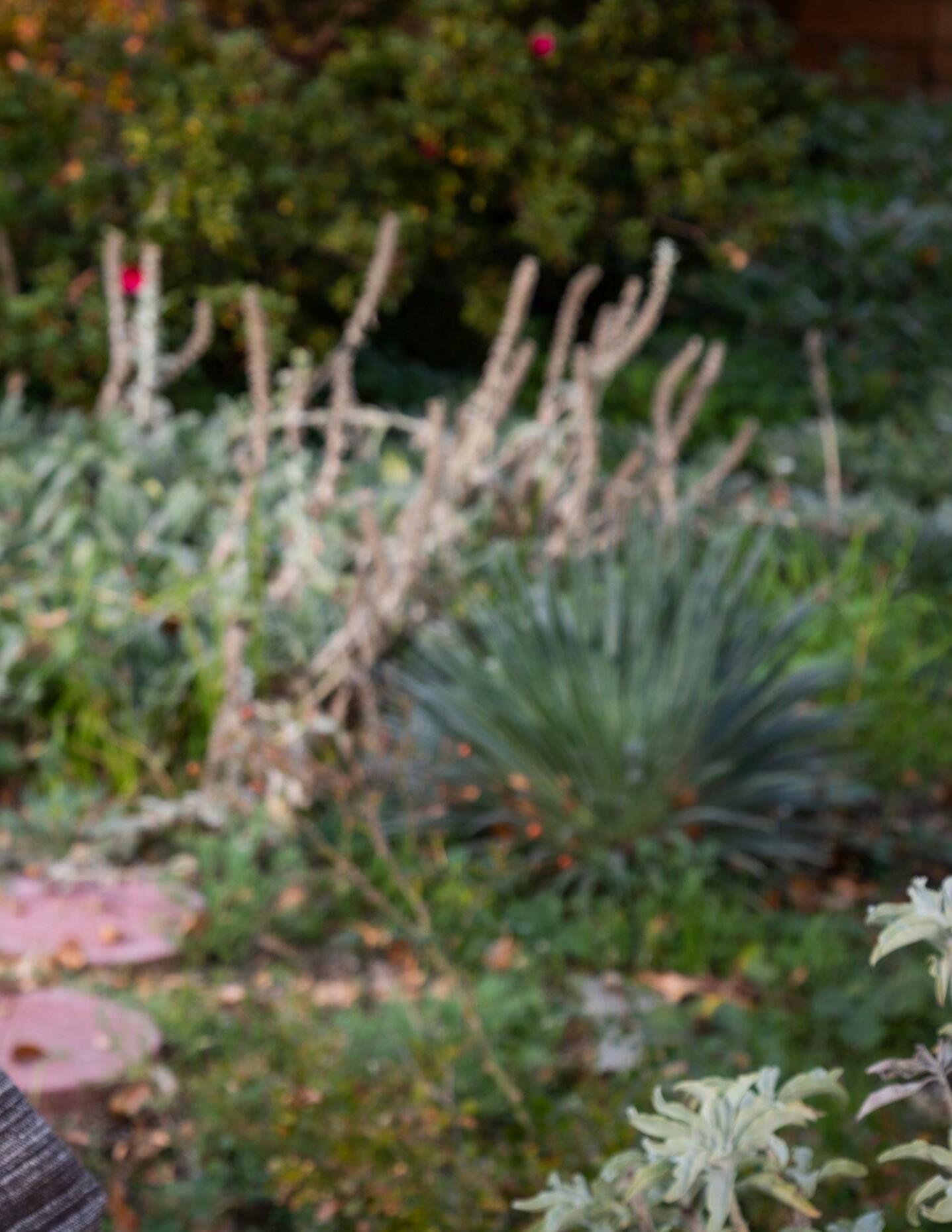
Her next stop was at an early internet station called Spinner.com in San Francisco. “I played all kinds of music, from bluegrass, Americana, country, rockabilly, to Southern Gospel. AOL bought it and called it Roots Music Radio. I was the director until it merged with Time Warner, and we were all out.” Not certain about the future of radio, Sully went back to school and got a teaching license in special education. She taught for a while, but Covid shut that down. But she is still very much in radio.

“I am on KKUP, a non-commercial station, one time a month, and on Bluegrass Country out of Washington, DC, once a week. I also do a show called Bluegrass Signal on KALW-FM once a month. I do the shows from home on my own little studio setup. I will do one original show live; then the stations run it a few times a week.”
Sully says she listens to all kinds of music but can’t do anything else when she is listening. “I can’t even listen to music when I drive. When Bela Fleck’s “My Bluegrass Heart” album came out, I almost wrecked the car listening to Slippery Eel.”
Women chefs across Appalachia preserve and elevate regional cuisine through traditional and modern techniques.
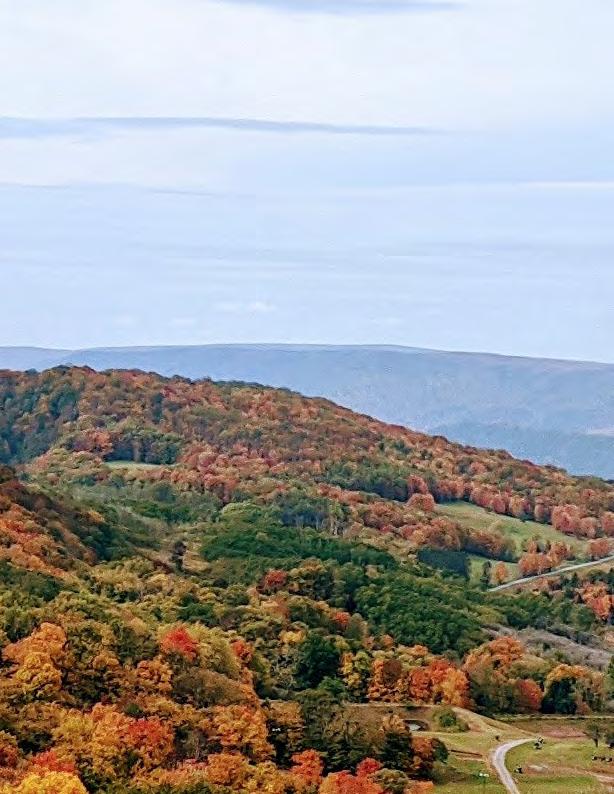
These chefs, sprinkled through North Carolina, Georgia, West Virginia, and other mountainous regions, are incorporating food rooted in place in the menus of their restaurants and encouraging others to appreciate the cuisine, as well.
Here are just a few women in the food industry helping tell stories through food throughout Appalachia.
Katie Button has been recognized by the James Beard Foundation, Food & Wine Magazine, and numerous other notable organizations championing the best of the best in food.
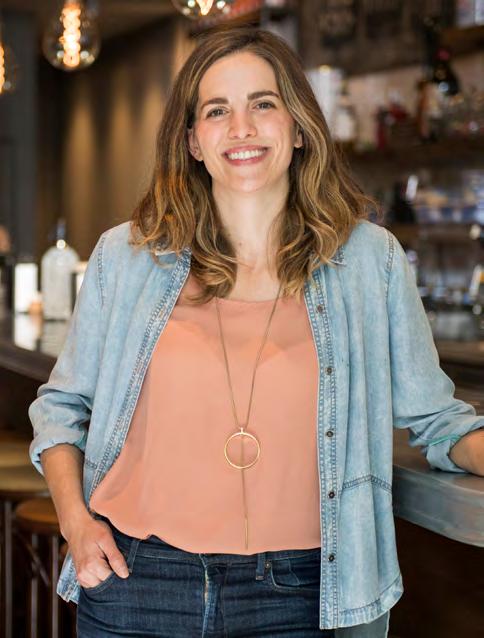
Button currently serves as the co-founder and CEO of Katie Button Restaurants, which
includes Curate Bar de Tapas and La Bodega by Curate. The restaurant group also operated two additional restaurants in Asheville: Nightbell, which closed after five years, and Button and Co. Bagels, which opened in 2018 and transitioned to La Bodega by Cúrate during the COVID-19
cheese topping.
Ashleigh Shanti is a chef and owner of Good Hot Fish, a pop-up fish fry in Asheville, North Carolina. Shanti also recently appeared on Top Chef Season 19, a Bravo TV cooking competition show.
pandemic, according to its website.
Button and Co. Bagels was known for incorporating Appalachian ingredients and traditions into its offerings. The bagels were made with locally milled wheat flour and sorghum syrup. Sumac, ramps, smoked mountain trout, and dried figs all made appearances within the dough or cream
She specializes in Black Appalachian foodways, including southern and soul food, and “creates dishes like country ham calas with hot chow chow; buttermilk biscuits with farmers’ cheese

and salmon roe butter; killed lettuces with vegetable bottarga and cured egg yolk; and grilled halibut with ramp rice grits, chanterelle escovitch, and fish skin cracklin’,” according to Eater.com.
In 2019, Shanti was named one of “16 Black Chefs Changing Food in America” by The New York Times. And she is continuing to make a name for herself as she travels throughout the region, dishing out delicious, inspired meals that have folks traveling from miles away.
“Smoked meats, fish, corn, beans, and foraged vegetables like mushrooms, muscadines, ramps, poke, sumac, berries, ginseng, chestnuts, plantain, artichokes, and dandelions were all known to indigenous tribes from north Georgia to Pennsylvania. Dishes like poke sallet, succotash, and cornbread all have roots in Cherokee, Seneca, and Iroquois cooking. Even country ham’s time-honored place in Appalachian cuisine is rooted in trade between indigenous peoples and Spanish settlers, with hogs making their way up old Indian roads from Florida to New England,” according to the restaurant’s website.
mushrooms, tomato jam, and smoked bacon; or an ovenroasted chicken with pan sauce, herbs, and potatoes.
If you want to learn how to cook dishes like these directly from Hart, you can attend her cooking school, where she walks students through a meal during a private class or public workshop.

Shelley Cooper joined the Dancing Bear Lodge & Bistro as the chef in Townsend, Tennessee, on Valentine’s Day in 2013. While she was at the helm, she had consistently blazed the path of creating incredible Appalachian food while embracing the region’s history.
Dancing Bear has been featured on The Travel Channel’s “Food Paradise” and The South’s 38 Essential Restaurants – Eater. com.
Chef Anne Hart’s eponymous restaurant, Hart Kitchen, focuses on seasonal and local ingredients, emphasizing classic food and beverage in the heart of Appalachia.


Before opening her current restaurant, Hart operated Provence Market and Cafe in Bridgeport, which had been recognized for its French cuisine before suffering a devastating fire in 2019. Just one year after the beloved restaurant went up in flames, Hart was serving her community once again - this time just a town over.
Hart Kitchen features daily specials with a revolving seasonal menu. You might find the warmed pimento cheese dip with housemade crackers; a burger with bourbon
While beans and cornbread might come to mind when you think of Appalachian food, these chefs have gone to great lengths to pay homage to tradition and continue to elevate Appalachian cuisine to include diverse foods beyond the stereotypes.
As women, these chefs have faced unique challenges in their journeys to find success, yet they continue to pursue a larger mission of promoting Appalachian food.
Whether you’re interested in trying a new food or want to gain a deeper understanding of the region, support these trailblazers who are creating works of art in edible form.






























